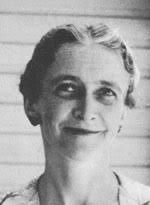While Jerry took a long sleep, I went to the handicraft exhibit until he joined me. It is unique. It combined county fair, arts and crafts, shop and garden and artistry, showing the things people can do with little to work with but a mind, some patience, and plenty of time. The enemy should have seen this display before writing an article on American love of luxury, idleness, and softness. At the door, outside, was a handsome white rooster with a red and blue ribbon tied to his leg. He was raised from a Camp Holmes egg, inside the barbed wire, by O’Dowd, Jake, and Bea, who are proud of it. The guard gazed with much amusement at the ribbons on the leg.
Among the items were: baby bedspreads with the names of all the camp-born babies embroidered on them; an egg cup carved as thin as china or a shell from wood by Dr. Skerl; Dick Patterson’s dirigible with tiny motors; lipstick made of beeswax from native honey and a dye; handmade dresses with handmade cocorut or stone buttons; tools—bow, saw, needles (from fence wire), wooden drills of bamboo, a handsome Swedish-style pocketknife with fine beveled edge and beautifully wrought handle by Lerberg (it is composed of an airplane strut, carabao horn, ramrod, copper wire, sewer pipe, and pouch fastener); a soup-bone crochet hook for his wife by Palmer, and the braided rug made with it by his wife; food covers from gauze taken off the back of adhesive tape; the prize aluminum false teeth by Fabian, with assistance from the dentist. Jim Thompson’s totem pole, hand carved, was there with his explanatory remarks— “Very rare totem pole, found in ruins of Camp Holmes, date about A.D. 1943. Believed to have been used by prehistoric totem cult; top figure is thought to represent the lamentations of the cult for their squareheadedness for getting in such a mess; the central figure symbolizing their national sickness (pigheadedness); the bottom figure represents the ultimate condition of these people—the rice belly.”
